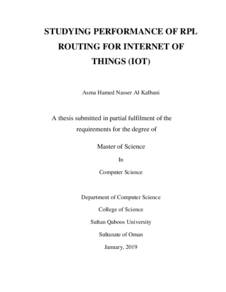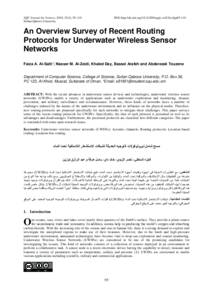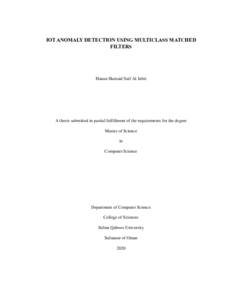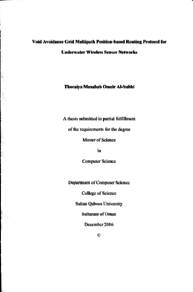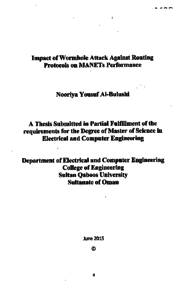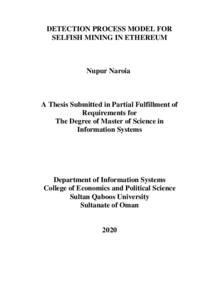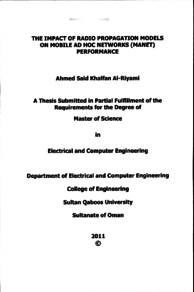Document
Studying performance of RPL routing for Internet of things (LOT)
Publisher
Sultan Qaboos University
Gregorian
2019
Language
English
Subject
English abstract
In recent years, there has been an increasing interest in Internet of Things (IoT). A Thing can be everything from cell phones, smart meters, headphones, lamps or any low power sensor node used to monitor physical and environmental conditions. IoT wireless network is formed of several small devices encompassing the capability of sensing a physical characteristic and sending it hop by hop to a central node. Wireless sensor networks are also termed as Low Power and Lossy Networks (LLNs). Designing energy efficient routing protocol for LLNs is very important to prolong the lifetime of the IoT network.The objective of this thesis is to analyze the performance of Routing Protocol for Low power and Lossy Network (RPL). RPL is IPv6 based Routing protocol for Low power and Lossy networks (ROLL) which is designed and proposed as standard by IETF (The Internet Engineering Task Force) by ROLL (Routing Over Low Power and Lossy Networks) group. RPL is a proactive distance vector based protocol that starts finding the routes as soon as the RPL network is constructing a DODAG (Destination Oriented Directed Acyclic Graph). RPL considers two metrics in Minimum Rank with Hysteresis Objective Function (MRHOF) to select the best routing path, which are: ETX (Expected Transmission Count) and Energy. mrhof_ETX objective function uses the number of transmissions needed to deliver packets successfully, while mrhof_Energy consider the node energy consumption in choosing the best route. The focus of this study is on studying the impact of using the different objective functions on the performance of the routing protocol in terms of number of control packets, energy consumption, latency and packet delivery ratio. The performance evaluation study was conducted using Cooja Simulator running Contiki operating system for different objective functions, different number of nodes and network density.We propose a new objective function where instead of using only ETX or Energy as metric, we will combine both of them. The objective functions of mrhof_ETX or mrhof_Energy each node selects its parent which have minimum ETX or Energy, therefor the proposed objective function will combine both ETX and Energy metrics.Experimental results show that the proposed WSOF decreases the Average Energy Consumption by 20 % and it decreases Number of Control Packets by 11 %. Also, it decreases the Network Latency by 20 % and it increases Packet Delivery Ratio by 21 %. These results are the average of all tested scenarios.In future studies, we need to conduct more simulation using different attributes such as different transmission range, more number of nodes, different network topology and compute the network lifetime.
Description
Thesis
Member of
Resource URL
Arabic abstract
تزايد الاهتمام في السنوات الاخيرة بإنترنت الاشياء، والشيء هنا يمكن أن يكون أي شيء من الهواتف المحمولة او العدادات الذكية او سماعات الرأس او المصابيح او المستشعرات قليلة الاستهلاك للطاقة المستخدمة لرصد الظروف البيئية والمادية . تتشكل شبكة انترنت الاشياء من العديد من الاجهزة الصغيرة التي تمتلك القدرة على استشعار الخصائص الفيزيائية وارسالها من مستشعر إلى مستشعر لتصل إلى نقطة مركزية، وتعرف ايض ا شبكات المستشعرات اللاسلكية بمصطلح الشبكات كثيرة الفقد ومنخفضة الطاقة، ومن المهم جد ا تصميم بروتوكول توجيه قليل الاستهلاك للطاقة لشبكات كثيرة الفقد ومنخفضة الطاقة لأجل إطالة عمر شبكة انترنت الاشياء . الهدف من هذه الأطروحة هو تحليل أداء بروتوكول التوجيه للشبكات كثيرة الفقد ومنخفضة الاستهلاك، وهذا البروتوكول هو بروتكول توجيه مبني على بروتوكول الإنترنت الإصدار 6 للشبكات كثيرة الفقد ومنخفضة الاستهلاك وهو مقترح كمعيار ومصمم من قبل مجموعة التوجيه عبر شبكات كثيرة الفقد ومنخفضة الاستهلاك التابعة لمجموعة مهندسي شبكة الإنترنت. بروتوكول التوجيه للشبكات كثيرة الفقد ومنخفضة الاستهلاك مبني على موجه المسافات الإستباقي الذي يبدأ في ايجاد المسارات بمجرد بدء شبكة البروتوكول في انشاء الشبكة الغير دائرية الموجهة الى نقطة معينة . لإختيار مسار التوجيه الأمثل فإن بروتوكل التوجيه للشبكات كثيرة الفقد ومنخفضة الاستهلاك ينظر في دالتين موضوعيتين وهما تكرار البث المتوقع والطاقة، تستخدم دالة تكرار البث المتوقع عدد مرات البث المطلوبة لإيصال البيانات بنجاح، بينما تقوم دالة الطاقة بالنظر في طاقة المستشعر لإختيار المسار الأفضل، ونركز في هذا البحث على دراسة أثر استخدام الدالات الموضوعية المختلفة على اداء بروتوكول التوجيه مثل عدد حزم التحكم واستهلاك الطاقة وبطء الإستجابة ومعدل توصيل البيانات، وقد نفذت دراسة تقييم الاداء باستخدام محاكي "كوجا" يعمل بنظام تشغيل"كونتيكي" لمختلف الدلالات الموضوعية وعدد المستشعرات وكثافة الشبكة . نقترح في هذا البحث استخدام دالة موضوعية جديدة حيث بدلا من استخدام احدى دالتي الطاقة او تكرار البث المتوقع كمقياس فإننا سندمجهما مع ا . فبدلا من ان الدالة الموضوعية للطاقة او تكرار البث المتوقع للمستشعر تقوم باختيار المسار ذو الطاقة الاقل او الاقل تكرارا للبث المتوقع، فإن اقتراحنا بأن تقوم الدالة الجديدة بدمج كلا الدالتين ومن ثم أخذ المجموع الأقل أظهرت نتائج التجارب بأن الدالة الموضوعية المقترحة احدثت تناقص في الطاقة المستهلكة من المستشعرات بنسبة%02 وفي عدد حزم التحكم بنسبة 11 % وفي بطء الإستجابة بنسبة 20 % بينما ازداد معدل توصيل البيانات بنسبة1 .%0 جميع هذه النتائج جمعت كمتوسط من كل التجارب المستخدمة. في الدراسات القادمة سنقوم بعمل المزيد من التجارب باستخدام عدة سمات مثل مدى ارسال مختلف وعدد اكبر من المستشعرات وشبكات مختلفة الأشكال وحساب عمر الشبكة الافتراضي
Category
Theses and Dissertations

